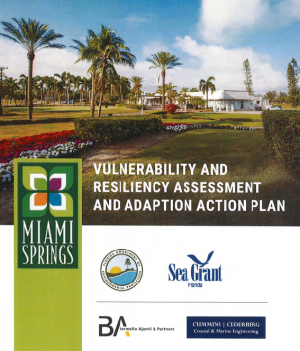Vulnerability and Resiliency Assessment and Adaptation Action Plan
PROJECT TITLE: City of Miami Springs Vulnerability and Resiliency Assessment and Adaptation Action Plan
PROJECT DESCRIPTION: The City of Miami Springs (Grantee) Vulnerability and Resiliency Assessment and Adaptation Action Plan (Project) will complete a comprehensive Vulnerability Assessment (VA) pursuant to Section 380.093, Florida Statutes (F.S.) for the City. The Project will also address the Peril of Flood recommendations and will assess exposure and sensitivity vulnerability of the City’s infrastructure critical assets for compliance with Section 380.093(3)(d), F.S. and will ensure that any future capital planning process incorporates the impact of flood risks due to climate change. The Project will include a geo database, modeling, critical asset inventory, comprehensive VA, and an Adaptation Action Plan (AAP) to evaluate and prioritize a dashboard of adaptation strategies with input from stakeholders.
Most of the City of Miami Springs is located in low-lying areas connected by the Miami Canal to Biscayne Bay and coastal waters, thus subjected to the perils of sea-level rise and the associated impacts to the City’s critical infrastructure. Although the City of Miami Springs can be considered
an inland municipality due to its location, it is vulnerable to the impacts of future storm surges and sea-level rise. The Flooding Vulnerability Map developed by Miami-Dade County shown in Appendix A, shows the areas of the City of Miami Springs that is vulnerable to storm surges and sea-level rise. Located close to the Miami International Airport and main communication lines like SR 27- W Okeechobee Road, Hialeah Express and SR-112 with connections to I-95 and SR-836 and the Palmetto SR-826, the City of Miami Springs plays a vital role in the local economy of South Florida.
Recent studies indicate that critical public infrastructure in Miami Springs, including access roads, bridges, utilities, parks, and conveyance systems, have already begun to show vulnerabilities to the current rising sea level, extreme rainfall, and seasonal high tides.
City of Miami Springs is taking a proactive approach to future flood resilience by performing a Sea Level Rise Vulnerability Assessment and Adaptation Study. The City has received funding by the Florida Department of Environmental Protection (FDEP) under the Resilient Florida Program to prepare a Vulnerability Assessment and Adaptation Plan to ensure compliance with the 2015 Peril of Flood legislation following the 2020 State of Florida Mitigation Action Plan guidelines.
Based on the Unified Sea Level Rise Projection for Southeast Florida updated in 2019 projects, the anticipated range of sea-level rise for the region from 2000 to 2120 is projected to rise 10 to 17 inches by 2040, 21 to 54 inches by 2070, and 10 to 136 inches by 2100. Specifically, the National
Oceanic and Atmospheric Association (NOAA) intermediate-high projections are adopted for this
study, and the King Tide elevations are mapped as a function of flood depth within the City’s
limits.
Upon completion of the collection of the background information on GIS and LIDAR available from the Miami-Dade County database, this report completes a vulnerability assessment to understand potential impacts of sea level rise hazards to the City’s critical assets and operations through
2070 by addressing the following questions:
• What areas of the City are most vulnerable to sea level rise impacts?
• What sea level conditions create critical scenarios that may result in widespread flooding that could affect the City operations?
• How does sea level rise affect critical assets?
What are the potential next steps to prepare the City for sea level rise resilience?
• Upon completion of the Vulnerability Assessment exposure and sensitivity analysis this report provides a toolbox of potential adaptation strategies to address flood risks to the City’s built infrastructure. This report includes planning and design guidance to provide a framework for
considering sea level rise within the city’s capital planning process. By preparing for future sea levels, the City of Miami Springs will become more resilient to future flood and storm events and remain a strong economic engine in the region.
Understanding the City’s potential vulnerabilities is an essential first step to development of potential adaptation strategies that will protect infrastructure, maintain operational continuity, and increase the long-term resilience of the City.

